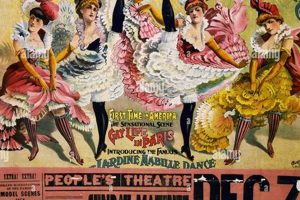Original advertising and artistic displays from bygone eras, specifically those originating from or related to New York City, constitute a distinct segment of collectible art. These items, often lithographs or early offset prints, offer a visual record of the city’s commercial and cultural history during periods like the Art Nouveau, Art Deco, and mid-century modern movements. Examples include advertisements for Broadway shows, transportation services like the subway or airlines, and products marketed to New Yorkers.
The importance of these historical artifacts lies in their multifaceted value. They serve as tangible links to the past, providing insights into design trends, consumer culture, and the evolving identity of New York City. Furthermore, their aesthetic appeal and rarity contribute to their value as investments and decorative pieces, attracting collectors, historians, and interior designers alike. Their preservation helps safeguard a unique form of visual communication, reflecting the socio-economic landscape of a specific time and place.
This article will delve into the identification, preservation, and valuation of such artifacts. It will also explore key sources for acquisition, including auction houses, specialized dealers, and online marketplaces. Finally, consideration will be given to the legal and ethical aspects of collecting and selling these historical documents.
Considerations for Acquiring Historical New York City Advertising Displays
The acquisition of original New York City advertising displays from past decades requires careful consideration and due diligence. Evaluating condition, rarity, and provenance is crucial for making informed decisions.
Tip 1: Assess Condition Meticulously: Prior to purchase, conduct a thorough inspection for signs of damage, including tears, fading, watermarks, and restoration efforts. Condition significantly impacts valuation and long-term preservation.
Tip 2: Verify Authenticity: Research printing techniques and paper types common to the era. Consult with experts to identify potential reproductions or forgeries, safeguarding investment and collection integrity.
Tip 3: Investigate Provenance: Trace the history of ownership and exhibition. Documentation, such as auction records or previous owner information, enhances value and provides insight into its historical context.
Tip 4: Understand Rarity Factors: Determine the printing run size, survival rate, and artist’s significance. Limited editions or pieces by renowned designers command higher prices and offer greater investment potential.
Tip 5: Scrutinize Pricing: Compare prices from reputable dealers, auction houses, and online marketplaces. Factor in condition, rarity, and demand when evaluating fair market value.
Tip 6: Prioritize Archival Storage: Implement proper storage techniques, including acid-free backing boards, archival sleeves, and UV-protective framing, to prevent deterioration and ensure long-term preservation.
Tip 7: Document Acquisitions Thoroughly: Maintain detailed records of purchases, including provenance information, condition reports, and appraisals. This documentation is essential for insurance purposes and future sales.
Diligent assessment and preservation strategies are essential for realizing the full historical and financial potential of these valuable cultural artifacts.
The following sections will address specific avenues for acquisition and ethical considerations for collectors.
1. Rarity
The rarity of vintage advertising displays from New York City directly influences their desirability and financial value. Scarcity arises from several factors, including limited print runs, intentional destruction after use, accidental damage, and loss over time. For example, advertisements created for short-lived Broadway productions or specific events, such as the World’s Fair, were often produced in smaller quantities, thereby increasing their relative rarity today. This scarcity is further amplified when considering the fragile nature of the paper and printing techniques employed, leading to degradation and loss of original prints.
The interplay between rarity and subject matter is also noteworthy. Items depicting iconic New York City landmarks, historical events, or featuring renowned artists command higher premiums due to their enhanced appeal and limited availability. Consequently, collectors actively seek out these scarce examples, driving up their value. The pursuit of such rare items contributes significantly to the robust market for vintage New York City advertising displays, fostering both investment opportunities and the preservation of cultural heritage. Auctions and specialized dealers often showcase these rare pieces, offering enthusiasts and investors the chance to acquire a tangible piece of New York City’s past.
Understanding rarity is essential for both novice and experienced collectors. Authenticating age and print run requires specialized knowledge and expertise, often involving consulting with experts and referencing historical archives. The inherent challenges in assessing rarity underscore the importance of provenance and condition reports in establishing value and authenticity. The ability to recognize and appreciate the nuances of rarity ultimately contributes to the informed collection and preservation of these historically significant artifacts, ensuring their continued appreciation by future generations.
2. Condition
The physical condition of antique advertising displays significantly affects their value and collectibility within the New York City market. Damage resulting from environmental factors, improper storage, or handling directly reduces aesthetic appeal and historical integrity. Tears, creases, fading, water damage, and foxing are common forms of degradation that diminish the desirability and monetary worth. For instance, an original subway advertisement for the 1939 World’s Fair, if preserved in pristine condition with vibrant colors and minimal imperfections, commands a substantially higher price than a similar advertisement exhibiting significant wear and tear. Condition, therefore, serves as a primary determinant in the valuation process.
Assessing condition necessitates a comprehensive evaluation of the print’s surface, edges, and backing. Professional conservation and restoration can mitigate some forms of damage, but the extent of intervention often influences long-term value. Over-restoration, while improving visual appearance, may compromise the authenticity and historical integrity, thereby impacting its status among collectors. Therefore, meticulous documentation of condition, including pre- and post-restoration reports, is crucial for transparency and establishing fair market value. Reputable dealers and auction houses typically provide detailed condition reports as part of their sales process, enabling potential buyers to make informed decisions based on objective assessments.
Ultimately, condition remains a paramount consideration for both collectors and investors in the vintage New York City advertising display market. While rarity and historical significance contribute significantly to value, the physical state often serves as the deciding factor in determining whether an acquisition aligns with specific collecting goals and investment strategies. The careful assessment and maintenance of condition not only preserves the aesthetic and historical value of these artifacts but also safeguards their long-term financial worth, ensuring their appreciation by future generations.
3. Artist Attribution
Within the realm of historical New York City advertising displays, artist attribution represents a critical factor in determining value, historical significance, and overall collectibility. Identifying the artist behind a given advertisement provides context, enhances provenance, and can dramatically influence market demand.
- Influence on Valuation
The recognition of a prominent artist’s hand in a vintage advertisement elevates its worth. Works by celebrated figures, such as A.M. Cassandre or Edward Penfield, command premium prices due to their established artistic reputation and historical importance. An advertisement signed or demonstrably attributable to a well-known artist becomes a coveted item among collectors and investors.
- Enhanced Historical Context
Attributing an advertisement to a specific artist illuminates the cultural and artistic movements of the time. The artist’s style, techniques, and influences provide insights into the aesthetic trends and socio-economic factors that shaped the design and marketing strategies of the period. For instance, an Art Deco advertisement designed by a prominent artist offers a glimpse into the visual culture of the 1920s and 1930s.
- Provenance and Authenticity
Establishing artist attribution strengthens provenance and aids in authenticating vintage advertising displays. A verifiable link to a known artist provides concrete evidence of originality and legitimacy, reducing the risk of acquiring reproductions or forgeries. Documentation, such as artist signatures, studio marks, or historical records, contributes to the overall confidence in the item’s authenticity.
- Market Demand and Collectibility
The presence of a recognized artist’s name significantly impacts market demand and collectibility. Collectors are often drawn to works by specific artists whose styles or themes resonate with their personal interests. Advertisements attributed to notable figures become highly sought-after items, fueling competition and driving up prices within the vintage market. This heightened demand underscores the importance of artist attribution in shaping the landscape of vintage New York City advertising display collecting.
In conclusion, artist attribution serves as a cornerstone in the evaluation and appreciation of historical New York City advertising displays. It enhances valuation, provides historical context, reinforces provenance, and fuels market demand. Recognizing and understanding the role of the artist behind these artifacts is essential for collectors, investors, and historians seeking to preserve and celebrate this unique aspect of New York City’s cultural heritage. The presence of a verifiable artist significantly amplifies the desirability and enduring value of these vintage displays.
4. Subject Matter
The subject matter depicted on antique advertising displays originating from New York City significantly influences their desirability and historical value. The imagery and themes represented serve as tangible links to the city’s past, reflecting its culture, commerce, and social trends. The specific subject matter can transform a commonplace advertisement into a highly sought-after collectible.
- Iconic Landmarks and Locations
Advertisements featuring well-known New York City landmarks, such as the Empire State Building, the Brooklyn Bridge, or Times Square, hold particular appeal. These images evoke a sense of nostalgia and represent quintessential aspects of the city’s identity. For example, a vintage advertisement promoting travel to New York City and showcasing the Statue of Liberty would inherently possess greater intrinsic value due to its universally recognizable subject matter.
- Cultural Events and Entertainment
Displays promoting significant cultural events, Broadway shows, or sporting competitions contribute to their collectibility. These items offer glimpses into the city’s vibrant entertainment scene and commemorate important moments in its history. A poster advertising the original run of “West Side Story” or a championship boxing match at Madison Square Garden represents a tangible connection to a specific era and cultural phenomenon.
- Transportation and Infrastructure
Advertisements related to New York City’s transportation system, including the subway, railroads, and airlines, are highly sought after by collectors. These items document the evolution of the city’s infrastructure and offer insights into the modes of transportation that shaped its growth. An advertisement for the Interborough Rapid Transit (IRT) or a Pan American Airways flight originating from LaGuardia Airport provides valuable historical context and visual representation of the city’s development.
- Commercial Products and Services
Displays promoting local businesses, products, and services provide a unique window into the city’s commercial landscape. These advertisements offer insights into the consumer culture of the past and reflect the changing tastes and preferences of New Yorkers. A vintage advertisement for a local department store, a classic New York deli, or a regionally manufactured product represents a valuable piece of the city’s commercial history.
In conclusion, the subject matter depicted on historical New York City advertising displays significantly impacts their collectibility and historical significance. By reflecting iconic landmarks, cultural events, transportation systems, and commercial activities, these advertisements offer a tangible connection to the city’s past, making them highly desirable items for collectors and historians alike. The subject matter, therefore, serves as a crucial determinant in evaluating the value and enduring appeal of these vintage artifacts.
5. Historical Context
The historical context surrounding antique advertising displays from New York City is paramount in understanding their significance and value. These items are not merely decorative; they are artifacts that encapsulate specific moments in the city’s cultural, economic, and social evolution. Examining their creation and usage within their original timeframe unlocks layers of meaning that resonate with collectors, historians, and enthusiasts.
- Economic Conditions and Advertising Strategies
The economic climate of a given era directly influenced advertising techniques and the subject matter promoted. During periods of prosperity, advertisements might showcase luxury goods and aspirational lifestyles. Conversely, during times of economic hardship, messaging would often emphasize value and practicality. For example, displays from the Great Depression era frequently highlight affordable goods and services, reflecting the prevailing economic anxieties of the time. This contextual understanding informs interpretations of these visual artifacts.
- Social and Cultural Movements
Antique advertising often reflects prevailing social and cultural movements. The rise of feminism, the Civil Rights movement, and evolving attitudes towards immigration are all mirrored in the imagery and messaging of advertisements from their respective periods. Analyzing such displays can provide insights into societal values, prejudices, and aspirations. For instance, advertisements from the mid-20th century often reveal subtle biases in gender roles and racial representation, offering a lens through which to examine societal norms of the time.
- Technological Advancements in Printing
The evolution of printing technology directly impacted the aesthetic qualities and production methods of advertising displays. From early lithography to advancements in offset printing, each technological shift resulted in distinct visual characteristics. Identifying the printing techniques employed can aid in dating and authenticating displays. For example, early chromolithographs are characterized by vibrant colors and intricate details achieved through laborious multi-stone printing processes. This knowledge helps collectors differentiate between original prints and later reproductions.
- Political Events and Propaganda
Political events and wartime mobilization significantly influenced advertising themes and objectives. During periods of conflict, advertisements often promoted patriotism, conservation, and support for the war effort. These displays serve as visual records of historical events and the propaganda techniques employed to influence public opinion. For example, World War II-era advertisements frequently depicted patriotic imagery and encouraged citizens to purchase war bonds or conserve resources. Analyzing these displays provides insight into the psychological strategies used to mobilize public support during times of crisis.
These facets demonstrate the profound connection between antique New York City advertising displays and the historical context in which they were created. By understanding the economic conditions, social movements, technological advancements, and political events that shaped these artifacts, collectors and enthusiasts can gain a deeper appreciation for their cultural and historical significance. These displays serve as tangible reminders of the city’s past, offering valuable insights into the lives, values, and aspirations of previous generations.
6. Print Quality
Print quality is a paramount determinant of value and authenticity in vintage New York City advertising displays. The techniques employed, the materials used, and the resulting visual fidelity contribute directly to the artifact’s historical significance and desirability. Inferior print quality often indicates reproduction, damage, or significant deterioration, all factors which negatively impact valuation and collectibility. For example, a poster from the 1930s utilizing high-quality lithography would exhibit crisp lines, vibrant colors, and a noticeable depth of image, distinguishing it from later, less refined reproductions.
Several factors contribute to the overall print quality of these vintage pieces. The type of printing process used (e.g., lithography, woodcut, silkscreen) defines the characteristic aesthetic. The inks employed dictate color longevity and vibrancy. The paper stocks weight, texture, and acidity influence its susceptibility to degradation over time. A vintage subway advertisement printed on high-quality, acid-free paper with fade-resistant inks is inherently more valuable than a similar piece printed on cheaper, more perishable materials. Understanding these elements allows collectors and enthusiasts to assess the authenticity and condition of these displays accurately, avoiding potential pitfalls in the market. Practical implications include the ability to distinguish between original prints and later reprints or digital reproductions, ensuring informed investment decisions.
In conclusion, print quality serves as a critical lens through which vintage New York City advertising displays are evaluated. Its influence spans authentication, valuation, and historical interpretation. While variations exist due to evolving printing technologies and intended audience, the assessment of print quality remains indispensable for preserving and appreciating these tangible artifacts of New York City’s past. Challenges in assessing print quality underscore the importance of expert consultation and meticulous examination, furthering the responsible collecting and preservation of these artifacts.
7. Provenance
The documented history of ownership, known as provenance, is a crucial factor in establishing the authenticity and value of vintage posters originating from New York City. A clear and verifiable chain of ownership, tracing the artifact back to its origin or early circulation, significantly enhances its credibility and desirability among collectors. The absence of provenance introduces uncertainty, potentially devaluing the item or raising concerns about its legitimacy. For instance, a vintage Broadway show poster with documented exhibition history at a renowned theater and subsequent sale through a reputable auction house would command a higher price than an identical poster lacking such documentation.
Verification of provenance typically involves researching auction records, dealer inventories, historical archives, and private collections. Documents such as bills of sale, exhibition catalogs, and correspondence related to the artifact’s past ownership serve as essential evidence. Establishing a continuous and credible chain of ownership minimizes the risk of acquiring forgeries or stolen items, safeguarding the collector’s investment. Furthermore, well-documented provenance provides valuable historical context, offering insights into the item’s creation, circulation, and reception. In practical terms, a collector might consult auction databases, such as those maintained by major auction houses, or work with specialized art historians to trace a poster’s ownership history.
In summary, provenance is an indispensable element in the world of vintage New York City posters, influencing authentication, valuation, and historical understanding. Challenges in establishing provenance, such as incomplete records or gaps in ownership history, necessitate thorough research and expert consultation. However, the effort invested in verifying provenance ultimately contributes to the long-term preservation and appreciation of these cultural artifacts. The link between provenance and the broader theme is that they ensure collectors are receiving the authentic item.
Frequently Asked Questions About Historical New York City Advertising Displays
This section addresses common inquiries regarding the acquisition, authentication, and preservation of vintage New York City advertising displays.
Question 1: What constitutes a “vintage” New York City advertising display?
A vintage advertising display generally refers to an original advertisement produced for commercial purposes in New York City, typically dating from the late 19th century through the mid-20th century. These items often reflect specific artistic styles and printing techniques prevalent during their respective eras.
Question 2: How can one determine the authenticity of a supposed vintage poster?
Authenticity verification requires careful examination of printing techniques, paper type, and subject matter. Consultation with experts in the field and comparison with known authentic examples is recommended. Provenance documentation, if available, further supports the item’s legitimacy.
Question 3: What are the primary factors that influence the value of these historical artifacts?
Value determinants include rarity, condition, artist attribution, subject matter, historical context, print quality, and provenance. Each of these factors contributes to the overall assessment of the item’s desirability and market worth.
Question 4: What are the best practices for preserving vintage paper advertising?
Preservation requires employing archival-quality materials, such as acid-free backing boards and protective sleeves. Storage in a climate-controlled environment, away from direct sunlight and extreme humidity, is essential. Professional framing with UV-protective glazing is also recommended.
Question 5: Where can one reliably acquire authentic examples of historical advertising displays from New York City?
Reputable sources include established auction houses specializing in vintage collectibles, experienced dealers with a proven track record, and reputable online marketplaces that offer detailed descriptions and authentication guarantees.
Question 6: Are there any legal or ethical considerations when buying and selling these items?
Ethical considerations include transparency in disclosing known flaws or restorations, and respecting copyright laws pertaining to the reproduction or distribution of images. Legal compliance with import/export regulations and sales tax requirements is also necessary.
Understanding these key considerations is paramount for responsible collecting and appreciation of these historically significant artifacts.
The subsequent sections will delve into resources for collectors and further explore the ongoing significance of these relics from New York City’s past.
Conclusion
The preceding exploration has illuminated the multifaceted value of vintage posters nyc as artifacts of cultural and commercial history. Key considerations such as rarity, condition, artist attribution, and provenance collectively determine the desirability and market value of these items. Furthermore, the understanding of historical context and printing techniques is essential for authentication and preservation.
The enduring appeal of these pieces lies in their ability to transport viewers to a bygone era, offering a glimpse into the aesthetic sensibilities and societal values of New York City’s past. Continued scholarly examination and responsible collecting practices are vital for ensuring that these tangible links to history are preserved for future generations. Further investigation into specific artists, thematic elements, and historical periods within the realm of New York City advertising displays promises to yield even greater insights into the city’s rich cultural heritage.







